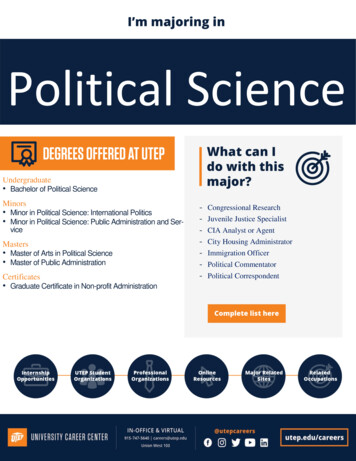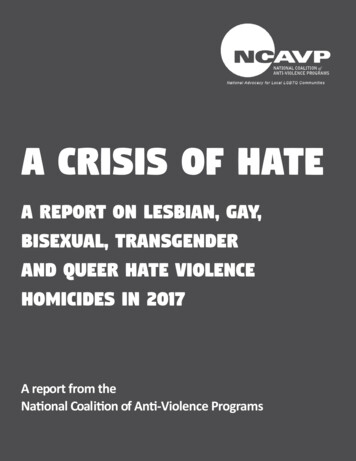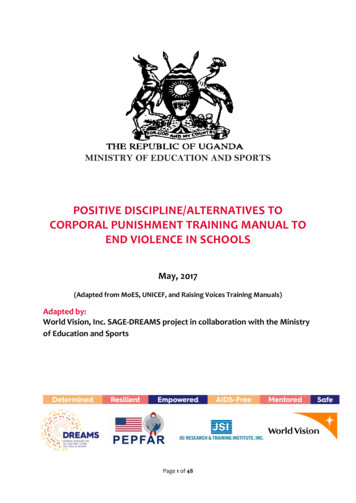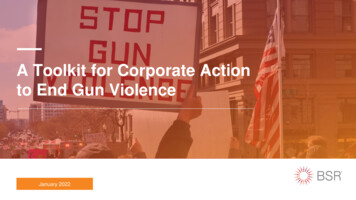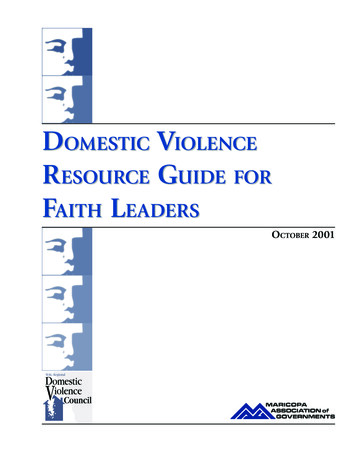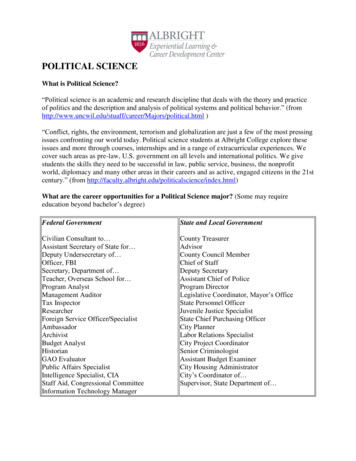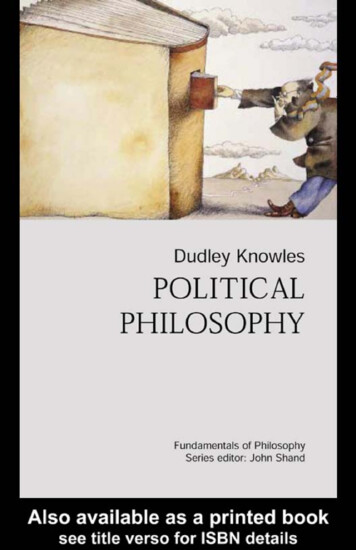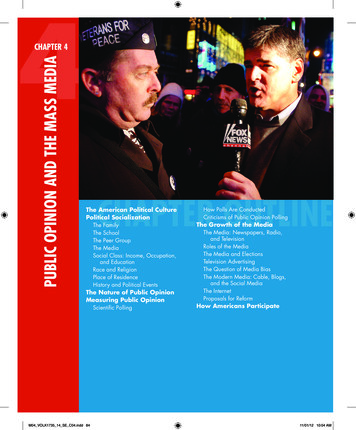
Transcription
SEPTEMBER 2020DEMONSTRATIONS & POLITICAL VIOLENCE IN AMERICANEW DATA FOR SUMMER 2020
IntroductionThe United States is at heightened risk of political violence and instability going into the 2020general election. Mass shootings hit a record high last year ( BBC, 29 December 2019 ), violent hatecrimes are on the rise ( Al Jazeera, 13 November 2019 ), and police killings continue unabated, at2.5 times the rate for Black men as for white men ( FiveThirtyEight, 1 June 2020 ; Nature, 19 June2020 ). The COVID-19 pandemic has killed well over 180,000 ( New York Times, 3 September2020 ) and disrupted the economy, while George Floyd’s death in police custody has sparked amassive wave of protest across the country. a joint project between ACLED and the Bridging Divides Initiative (BDI) atThe US Crisis Monitor —Princeton University — collects real-time data on these trends in order to provide timely analysisand resources to support civil society efforts to track, prevent, and mitigate the risk of politicalviolence in America. With supplemental data collection e xtending coverage back to the week ofFloyd’s killing in May, the dataset now encompasses the latest phase of the Black Lives Mattermovement, growing unrest related to the health crisis, and politically motivated violence ahead ofthe November general election.The US Crisis Monitor is made possible by support from the Bridging Divides Initiative at the Princeton Schoolof Public and International Affairs’ Liechtenstein Institute on Self-Determination.
These data reveal that the United States is in crisis. It faces a multitude of concurrent, overlappingrisks — from police abuse and racial injustice, to pandemic-related unrest and beyond — allexacerbated by increasing polarization. This report maps these trends with a view toward theupcoming election, when these intersecting risks are likely to intensify.Black Lives Matter: Racism & Police ViolenceThe longstanding crisis of police violence and structural racism in America hit a new flashpointthis year. On 25 May 2020, Minneapolis police officers arrested George Floyd, a 46-year-old Blackman, for allegedly using a counterfeit 20 bill. One officer pinned Floyd to the ground and kneeledon his neck for eight minutes and 15 seconds, killing him. Other officers looked on ( BBC, 16 July2020 ).Floyd’s death prompted a surge of demonstrations associated with the Black Lives Matter (BLM)1movement that quickly spread from Minneapolis throughout the country. Between 26 May, theday after Floyd’s death, and 22 August, ACLED records over 7,750 demonstrations linked to theBLM movement across more than 2,440 locations in all 50 states and Washington, DC.While Floyd’s killing ignited the demonstrations, the protest movement has also organized aroundother victims of police violence and racism across the country. In August 2019, police officersconfronted Elijah McClain while hewas walking home from aconvenience store in Aurora,Colorado. McClain died afterauthorities reportedly tackled him,put him in a carotid hold, and hadfirst responders inject him withketamine ( The Cut, 11 August2020 ). At the start of 2020,Ahmaud Arbery was shot andkilled by a former police officerand his son while out jogging insouth Georgia ( New York Times,24 June 2020 ). The assailantsclaim they suspected him ofbreaking into nearby homes. In1In this report, the acronym “BLM” is used to abbreviate the phrase “Black Lives Matter” when referring to the movement writlarge. It is not meant to suggest all associated events are directly affiliated with the national BLM organization.
Louisville, Kentucky, police raided the wrong home while attempting to serve a warrant andexchanged gunfire with one of the occupants; his partner, Breonna Taylor, a 26-year-oldparamedic who was sleeping at the time, was shot and killed by the officers ( New York Times, 1September 2020 ). Demonstrations over Floyd’s killing have also called for justice in these casesand other past incidents that remain unresolved. In many local communities, protests markingFloyd’s death have doubled as acts of remembrance for people like Michael Brown, Eric Garner,Freddie Gray, and Trayvon Martin — whose killing in 2012 originally sparked the BLM movement( CNN, 26 February 2017 ). Even amid the current round of demonstrations, new cases have beenadded to the list, from Rayshard Brooks, an unarmed Black man killed by police in Atlanta, Georgia( CNN, 15 June 2020 ), to Jacob Blake, an unarmed Black man shot seven times by police inKenosha, Wisconsin ( CBS News, 26 August 2020 ).The demonstrations remain ongoing. Though reported events associated with the BLM movementhave gradually declined since their peak in late May and early June, ACLED still continues torecord dozens of demonstrations each week ( see graph below ).
An Overwhelmingly Peaceful MovementThe vast majority of demonstration events associated with the BLM movement are non-violent( see map below ). In more than 93% of all demonstrations connected to the movement,demonstrators have not engaged in violence or destructive activity. Peaceful protests are reportedin over 2,400 distinct locations around the country. Violent demonstrations, meanwhile, havebeen limited to fewer than 220 locations — under 10% of the areas that experienced peacefulprotests. In many urban areas like Portland, Oregon, for example, which has seen sustained unrestsince Floyd’s killing, violent demonstrations are largely confined to specific blocks, rather thandispersed throughout the city ( CNN, 1 September 2020 ).Yet, despite data indicating that demonstrations associated with the BLM movement areoverwhelmingly peaceful, one recent poll suggested that 42% of respondents believe “mostprotesters [associated with the BLM movement] are trying to incite violence or destroy property”( FiveThirtyEight, 5 June 2020 ). This is in line with the Civiqs tracking poll which finds that “netapproval for the Black Lives Matter movement peaked back on June 3 [the week following the
killing of George Floyd when riots first began to be reported] and has fallen sharply since” ( USAToday, 31 August 2020 ; Civiqs, 29 August 2020 ).Research from the University of Washington indicates that this disparity stems frompolitical orientation and biased media framing ( Washington Post, 24 August2020 ), such as disproportionate coverage of violent demonstrations ( Business Insider, 11June 2020 ). Groups like the Anti-Defamation League (ADL) have documented organizeddisinformation campaigns aimed at spreading a “ deliberate mischaracterization of groups ormovements [involved in the protests], such as portraying activists who support Black LivesMatter as violent extremists or claiming that antifa is a terrorist organization coordinated ormanipulated by nebulous external forces” ( ADL, 2020 ). These disinformation campaignsmay be contributing to the decline in public support for the BLM movement after the initialincrease following Floyd’s killing, especially amongst the white population ( USA Today, 31August 2020 ; C iviqs, 30 August 2020a , 3 0 August 2020b ). This waning support also comes asthe Trump administration recently shifted its “law and order” messaging to target localDemocratic Party politicians from urban areas, particularly on the campaign trail ( NPR,27 August 2020 ).Despite the media focus on looting and vandalism, however, there is little evidence to suggestthat demonstrators have engaged in widespread violence. In some cases wheredemonstrations did turn violent, there are reports of a gents provocateurs — or infiltrators — instigating the violence. During a demonstration on 27 May in Minneapolis, forexample, a man with an umbrella — dubbed the ‘umbrella man’ by the media and lateridentified as a member of the Hells Angels linked to the Aryan Cowboys, a whitesupremacist prison and street gang — w as seen smashing store windows ( Forbes, 30 May2020 ; K STP, 28 July 2020 ). It was one of the first reports of destructive activity thatday, and it “created an a tmosphere of hostility and tension” that helped spark an outbreakof looting following initially peaceful protests, according to police investigators, who believethe man “wanted to sow discord and racial unrest ” ( New York Times, 28 July 2020 ). Inanother example on 29 May in Detroit, a number of non-residents reportedly traveled tothe city to engage in violent behavior during a demonstration, leading to multiple arrests( MLive, 2 June 2020 ).In many cases, violent or destructive demonstrations have specifically targeted statuesseen to represent the country’s legacy of racist violence, such as monuments celebratingcolonial figures, slave owners, and Confederate leaders. Since Floyd’s killing, there havebeen at least 38 incidents in which demonstrators have significantly damaged or torndown memorials around the country, including statues of Confederate President JeffersonDavis and colonial explorer Christopher Columbus. Although these incidents account fora small subset of demonstrations, the trend has become another battlefield for thehyper-partisan “culture wars” over America’s history of racism ( Bloomberg, 7 June2020 ), and a lightning rod for polarized debate over an appropriate response to the ongoingprotest movement. In some communities, pressure has led to official efforts to removemonuments and to rename public facilities like schools, with town hall meetings and other
fora providing peaceful opportunities for discussion and reconciliation, which can ultimatelyhelp to reduce polarization ( NPR, 12 July 2020 ). In others, however, clashes have broken outbetween those opposed to these memorials, such as the Stone Mountain monument toConfederate leaders in Georgia, and those who support keeping them ( AJC, 15 August 2020 ).By the end of June, President Donald Trump seized on the topic to issue an executive orderauthorizing federal agents to pursue demonstrators who pull down statues or damage federalproperty, spurring the creation of the Protecting American Communities Task Force (PACT)and the deployment of Department of Homeland Security (DHS) agents to protest sites across theUS.A Violent Government ResponseThe initial government response to the demonstrations was not uniform. Many early protestswere held peacefully and without incident. In certain cities, like Los Angeles, California andCamden, New Jersey, authorities even expressed support by joining marches, taking a knee, orattending community meetings on reform ( ABC7, 1 June 2020 ; CBS8, 15 June 2020 ; NJ Spotlight,12 June 2020 ). In some cases these efforts reduced tensions between the community and thepolice, while in others demonstrators raised concerns that these displays served more as “PRstunts” than genuine acts of solidarity, potentially obscuring the scope of police abuse ( ABC, 6June 2020 ). At the start of June, for example, while some police officers kneeled withdemonstrators in Buffalo, New York, separate reports surfaced showing the city’s police violentlypushing an elderly protester to the ground, fracturing his skull, the next day ( ABC, 6 June 2020 ; NPR, 30 June 2020 ).Overall, ACLED data indicate that government forces soon took a heavy-handed approach to thegrowing protest movement. In demonstrations where authorities are present, they use forcemore often than not. Data show that they have disproportionately used force whileintervening in demonstrations associated with the BLM movement, relative to other types ofdemonstrations.Despite the fact that demonstrations associated with the BLM movement have beenoverwhelmingly peaceful, more than 9% — or nearly one in 10 — have been met withgovernment intervention, compared to 3% of all other demonstrations. This also marks a generalincrease in intervention rates relative to this time last year. In July 2019, authorities intervened inunder 2% of all demonstrations — fewer than 30 events — relative to July 2020, when theyintervened in 9% of all demonstrations — or over 170 events.Authorities have used force — such as firing less-lethal weapons like tear gas, rubber bullets, andpepper spray or beating demonstrators with batons — in over 54% of the demonstrations inwhich they have engaged. This too is a significant increase relative to one year ago. In July 2019,government personnel used force in just three documented demonstrations, compared to July2020, when they used force against demonstrators in at least 65 events. Over 5% of all eventslinked to the BLM movement have been met with force by authorities, compared to under 1% of
all other demonstrations. In some contexts, like Seattle, Washington and Portland, Oregon ( seebelow), the heavy-handed police response appears to have inflamed tensions and increased therisk of violent escalation ( New York Times, 31 May 2020 ).Militarized Federal ReactionThe escalating use of force against demonstrators comes amid a wider push to militarize thegovernment’s response to domestic unrest, and particularly demonstrations perceived to belinked to left-wing groups like Antifa, which the administration views as a “terrorist” organization( New York Times, 31 May 2020 ). In the immediate aftermath of Floyd’s killing, President Trumpposted a series of social media messages threatening to deploy the military and National Guard todisperse demonstrations, suggesting that authorities should use lethal force if demonstratorsengage in looting ( New York Magazine, 1 June 2020 ). The president called governors “weak” forallowing demonstrations in their states and instructed them to call in the National Guard to“dominate” and “cut through [protesters] like butter” ( Vox, 2 June 2020 ). Senator Tom Cottonfrom Arkansas, an advisor to the president, recommended that the administration “send in thetroops” and give “no quarter for insurrectionists, anarchists, rioters, and looters” ( New YorkTimes, 3 June 2020 , 23 June 2020 ).Rhetoric soon translated to action: in early June, the government used National Guard troops,Secret Service agents, and US Park Police — among other federal agents — to violently dispersepeaceful protests in Lafayette Square outside the White House to create a photo opportunity at St.John’s Church ( Vox, 2 June 2020 ; New York Times, 10 June 2020 ). The incident prompted a rarepublic condemnation from former Secretary of Defense James Mattis and an eventual refusal fromcurrent Defense Secretary Mark Esper to support the invocation of the Insurrection Act, whichwould allow the deployment of active-duty troops to respond to demonstrations ( Atlantic, 3 June2020 ; TIME, 3 June 2020 ). Still, by the end of the month, DHS established the PACT and deployedagents around the country, including in Portland, Oregon; Seattle, Washington; and Washington,DC ( Al Jazeera, 23 June 2020 ). Since Floyd’s killing, ACLED records over 55 federal and NationalGuard deployments across the country, including members of PACT as well as forces affiliatedwith Operations Legend and Diligent Valor.Seattle, WashingtonSeattle became an early hotspot of the protest movement and a target of the crackdown.Washington’s governor swiftly deployed the National Guard throughout the state and byIndependence Day weekend the federal government sent agents assigned to PACT to guardmonuments and to quell demonstrations. Demonstrators remained largely peaceful, but tensionsrose as standoffs outside the Seattle Police Department’s East Precinct intermittently turnedviolent, with widespread use of tear gas, flashbang grenades, and pepper spray( Spokesman-Review, 3 June 2020 ).
In early June, under pressure from elected officials raising allegations of excessive force, policewithdrew from the East Precinct and demonstrators established a protest encampment they calledthe Capitol Hill Occupied Protest (CHOP) zone, independent of police and government control( Seattle PI, 22 June 2020 ). While CHOP was marred by criminal violence ( Vox, 2 July 2020 ), thecreation of the encampment coincided with a lull in violent demonstrations. Although riots werereported before 8 June (when CHOP was established) and after 1 July (when it was dismantled),only peaceful protests were recorded during the intervening period ( see graph below ).Authorities cleared CHOP and arrested dozens of demonstrators by the start of July, but theepisode set an important precedent: President Trump warned that protesters would be met with“serious force” if they attempted to replicate CHOP elsewhere in the country ( Washington Post, 24June 2020 ).Portland, OregonAfter Seattle, the heavy-handed government response took center stage in Portland, wheredemonstrators have gathered daily since Floyd’s killing. Throughout June, demonstrators ralliedoutside the Multnomah County Justice Center and other prominent government sites in downtownPortland, sporadically clashing with police who blanketed the city with tear gas and impactmunitions. A federal judge soon issued a restraining order against the Portland Police Bureau,
instructing it to limit the use of tear gas over concerns that its officers were employing excessiveforce against demonstrators and violating their Fourth Amendment rights ( OPB, 19 July 2020 ) . Bythe end of the month, the order was expanded to restrict the use of other less-lethal weaponry likerubber bullets, and Oregon state legislators passed a new law that mandated police warnprotesters before firing tear gas. Demonstrations continued, but tensions cooled.The situation changed in July, when PACT agents and other federal personnel took a more activerole in the response as part of Operation Diligent Valor. Against the wishes of local officials( Business Insider, 22 July 2020 ), federal authorities began aggressively policing thedemonstrations, using excessive force and arbitrarily detaining suspected protesters in unmarkedvehicles ( Oregon Live, 16 July 2020 ; USA Today, 4 August 2020 ).Prior to the deployment of PACT at the start of July, approximately 8% of demonstrations inOregon were met with government intervention, and authorities infrequently used force againstdemonstrators. Since July, however, nearly 28% of demonstrations have been met withintervention and force by government personnel. In Portland specifically, under 24% ofdemonstrations were met with state force before July. Since July, this figure has risen to 40% of alldemonstrations ( see graph below ).Although federal authorities were purportedly deployed to keep the peace, the move appears tohave re-escalated tensions. Prior to the deployment, over 83% of demonstrations in Oregon werenon-violent. Post-deployment, the percentage of violent demonstrations has risen from under
17% to over 42% ( see graph below ), suggesting that the federal response has only aggravatedunrest. In Portland, violent demonstrations rose from 53% to nearly 62% of all events afterfederal agents arrived on the scene.In late July, officials announced that federal agents would reduce their presence in Portlandfollowing talks between Governor Kate Brown and Vice President Mike Pence, but would remainon standby ( Guardian, 29 July 2020 ) . Some reports indicate that the pullback has lowered tensions( The Week, 3 August 2020 ), but President Trump has warned that federal authorities will not fullyleave Portland until local authorities “ secure their city” ( Guardian, 29 July 2020 ). As of earlySeptember, the federal government began deputizing Oregon State Police to respond todemonstrations in Portland, in coordination with US Marshals, potentially signalling renewedfederal intervention in the city ( KOIN, 1 September 2020 ).Widespread Attacks on the PressReporters have also been targeted as part of the government response. As journalists have workedto cover the unprecedented wave of protests, they have simultaneously faced what ReportersWithout Borders has called “an unprecedented outbreak of violence” around the country ( RSF, 31May 2020 ). Government forces are the primary perpetrators of these attacks, from beatings andassaults to violent arrests. Since May, ACLED records over 100 separate incidents of governmentviolence against journalists in at least 31 states and Washington, DC during demonstrationsassociated with the BLM movement ( see map below ). The greatest number of these have occurred
in California — such as on 30 May at a demonstration in Santa Monica when police hit an ABC7news crew with tear gas ( ABC7, 31 May 2020 ), or on 31 May at a demonstration in Long Beachwhen police injured a KPCC/LAist journalist with non-lethal rounds ( LAist, 31 May 2020 ).
High Rates of Non-state Actor Involvement in BLM DemonstrationsGovernment forces are not the only actors intervening in demonstrations. Amid increased politicalpolarization and deepening mistrust in state institutions, militias and other non-state actors areincreasingly engaging with demonstrators directly.Non-state groups are becoming more active and assertive. Since May, ACLED records over 100events in which non-state actors engaged in demonstrations (including counter-demonstrations)— the vast majority of which were in response to demonstrations associated with the BLMmovement. These non-state groups include organizations and militias from both the left and rightside of the political spectrum, such as Antifa, the Not Fucking Around Coalition, the New MexicoCivil Guard, the Patriot Front, the Proud Boys, the Boogaloo Bois, and the Ku Klux Klan, amongothers ( see map below ).
Overall, over 20 distinct non-state groups have actively engaged in demonstrations this summer.In July 2020 alone, ACLED records nearly 30 events in which non-state actors engageddemonstrators — up from zero in July 2019.Whether they are affiliated with an organized group or not, there is also a growing presence ofarmed individuals at demonstrations, with many claiming they are standing by to ‘keep the peace’if not to openly intimidate perceived ‘enemies.’ At least 50 such incidents have been reportedaround the country since 24 May. Reports that police not only tolerate the presence of certainarmed individuals at demonstrations ( Washington Post, 30 August 2020 ; Huffington Post, 28August 2020 ), but in some cases actively encourage their involvement suggest this trend willcontinue, amplifying the risk of violence. On the night of 25 August in Kenosha, Wisconsin, forexample, during protests against police brutality following the shooting of Jacob Blake, policeallegedly told armed members of the Kenosha Guard over a loudspeaker, “We appreciate you guys.We really do,” and shared water with them ( USA Today, 29 August 2020 ).While many of these incidents have not turned violent, recent events in Kenosha indicate just howquickly the situation can escalate.2 A call to arms on Facebook by the Kenosha Guard broughtmultiple armed individuals to the city to ‘protect lives and property,’ including those nottechnically affiliated with the group — such as Kyle Rittenhouse. Before the end of the night,Rittenhouse shot three demonstrators, two of whom died of their injuries ( CNN, 28 August 2020 ).Police initially allowed Rittenhouse to leave the scene, but he was later arrested and charged with2This report includes data from 24 May through 22 August 2020. Events from 23 August onwards, including violence inKenosha, Wisconsin on 25 August, will be included in subsequent data releases by the US Crisis Monitor .
homicide. Since then, President Trump has failed to condemn Rittenhouse’s actions, and hassuggested that the shootings were in self-defense ( NPR, 31 August 2020 ).A Rising Number of Counter-Protests Turning ViolentIn addition to armed individuals standing by without directly engaging demonstrations, there hasalso been an increase in the number of counter-protests confronting opposing demonstrators.3Between 24 May and 22 August, over 360 counter-protests were recorded around the country,accounting for nearly 5% of all demonstrations. Of these, 43 — nearly 12% — turned violent, withclashes between pro-police demonstrators and demonstrators associated with the BLMmovement, for example. In July alone, ACLED records over 160 counter-protests, or more than 8%of all demonstrations. Of these, 18 turned violent. This is a significant increase relative to July2019, when only 17 counter-protests were reported around the country, or approximately 1% ofall demonstrations, and only one of these allegedly turned violent.This trend threatens to quickly escalate confrontations between protesters andcounter-protesters into violent clashes. Recent events in Portland, Oregon on the night of 29August point to how such confrontations can rapidly turn deadly.4 On that night, a caravandemonstration — including members of Patriot Prayer, Three Percenters, and Proud Boys — s drove trucksthrough the crowd and shotpaintball guns and peppersprayatcounter-demonstratorsrallying in support of theBLM movement. During theconfrontation a member oftheright-wingPatriotPrayer armed group wasshot dead by an unknownindividual. President Trumptweeted a message ofcondolencesforthedeceased, alleging that he3These are events in which demonstrators are met with counter-protesters. If two protests occur at the same time, in the sameplace, and they are essentially ‘counter’ to one another — for example, one is pro-BLM, and the other is anti-BLM — the eventsare coded as a single event instead of as two separate events. Depending on whether each side engages in destructive or disruptivebehavior, the actor on each side is coded accordingly.4 This report includes data from 24 May through 22 August 2020. Events from 23 August onwards, including violence inPortland, Oregon on the night of 29 August, will be included in subsequent data releases by the US Crisis Monitor.
had been “murdered in Portland by ANTIFA” ( Insider, 31 August 2020 ), despite the fact that itremains unclear who is responsible for the shooting.The rise in non-state intervention and violent counter-demonstrations is set against a growingpattern of non-violent hate incidents. As racial justice protests have spread across the country, sotoo have displays of racist symbols like nooses, believed to be warnings or acts of intimidationtargeting activists and protesters associated with the BLM movement. In late June, for example, astuffed animal monkey was found hanging from a tree in Santa Rosa, California ( ABC, 29 June2020 ). In mid-July, a couple in Saginaw, Michigan found a noose and a note saying “Accessory to beworn with your BLM T-shirt! Happy Protesting!” slipped through the window of their car( Michigan Live, 13 July 2020 ).Comparing BLM Trends GloballyWhile the US faces a unique combination of overlapping crises, many of these trends are mirroredaround the world — and the racism and police brutality exemplified by the killing of GeorgeFloyd prompted a global response.In the week’s since Floyd’s killing, at least 8,700 demonstrations in solidarity with the BLMmovement were reported across 74 countries, including the US. Demonstrators focused theiroutrage on American symbols — including embassies, consulates, and Trump properties — butthey also rallied around local cases of police brutality and racial inequality. T he BLM movementhas offered a ‘brand’ of anti-racism and anti-police violence activism for a range of contextsaround the world. In many countries, demonstrators have been ‘applying their own martyrs’ tothe solidarity protests, and are using BLM as an inspiration for structuring domestic movementsagainst police violence, discrimination, and political repression.
COVID-19: A Global Health CrisisUnrest over police brutality and racist violence erupted at the height of another crisis: theCOVID-19 pandemic. America has emerged as the new epicenter of the coronavirus outbreak. Withonly 4% of the world’s population, the US was estimated to have a quarter of confirmed cases bythe end of June ( CNN, 30 June 2020 ). At time of writing, more than 180,000 Americans have died,and over six million have been infected ( New York Times, 1 September 2020 ).COVID-19 and the Black Lives Matter MovementIn America, the health crisis and the latest wave of demonstrations associated with BLM areintertwined. The current BLM protest movement has become one of the largest in US history inpart because it emerged within a socio-economic environment deeply disrupted by the pandemic.Research indicates that people who lost their jobs and livelihoods are more likely to participate inthe protests ( Washington Post, 5 August 2020 ), especially as the pandemic has left clear winnersand losers in its wake. The “Strike for Black Lives” for example, is an effort to unite “theinterconnected fights for racial and economic justice” ( USA Today, 20 July 2020 ). As part of thismovement, essential workers have been protesting in remembrance of George Floyd, BreonnaTaylor, Elijah McClain, and other Black people killed by police, while also calling for the Senate topass the Health and Economic Recovery Omnibus Emergency Solutions ( HEROES) Act: a stimuluspackage to address the pandemic’s economic impact — which has hit some harder than others.The number of Black Americans working in front-line jobs impacted by the pandemic isdisproportionately high, Black workers continue to earn less than their white counterparts( SHRM, 11 June 2020 ), and almost half of Black households are concerned with their ability tomake rent on a monthly basis ( CBS News, 16 June 2020 ; SHRM, 26 June 2020 ; Urban Institute, 2June 2020 ). According to the Brookings Institution, COVID-19 has now become the third largestcause of death amongst the Black population ( CBS News, 17 August 2020 ).Impacts of the COVID-19 PandemicThe economic fallout from the pandemic is devastating. According to the University of NewHampshire, all 50 states have experienc
which they have engaged. This too is a significant increase relative to one year ago. In July 2019, government personnel used force in just three documented demonstrations, compared to July 2020, when they used force against demonstrators in at least 65 events. Over 5% of all events
